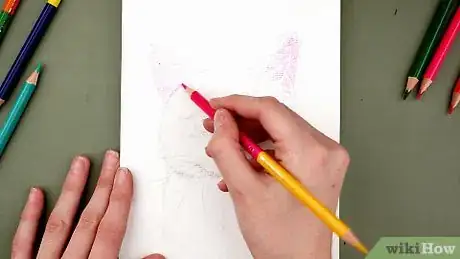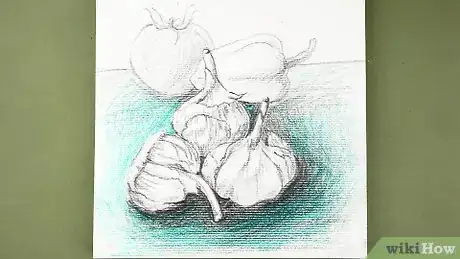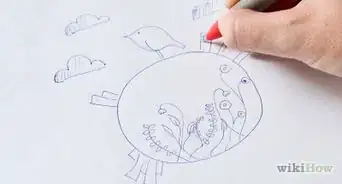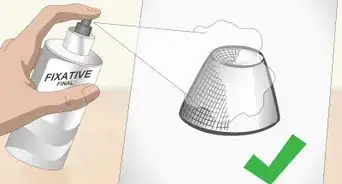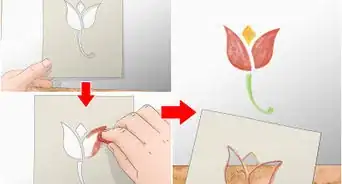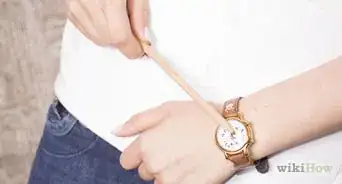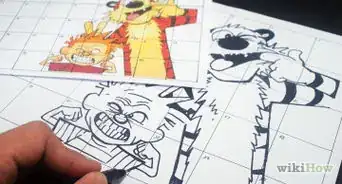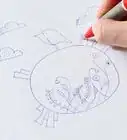This article was co-authored by wikiHow staff writer, Hannah Madden. Hannah Madden is a writer, editor, and artist currently living in Portland, Oregon. In 2018, she graduated from Portland State University with a B.S. in Environmental Studies. Hannah enjoys writing articles about conservation, sustainability, and eco-friendly products. When she isn’t writing, you can find Hannah working on hand embroidery projects and listening to music.
There are 8 references cited in this article, which can be found at the bottom of the page.
The wikiHow Video Team also followed the article's instructions and verified that they work.
This article has been viewed 17,721 times.
Learn more...
If you’ve ever tried to draw a white subject on a white piece of paper, you probably know how tough it can be. Making your subject stand out instead of fading into the background is no easy feat, but it can be done! With a few tips and tricks, you can make your white drawing distinct from its white background in no time.
Steps
Colored Pencil
-
1Start with the lighter tones. This will help you preserve the overall light color of your subject. Go for light grays, light pinks, and light browns as you start in on your drawing.[1]
- This is especially important for white fur. Using lighter tones first will help it look more realistic.
-
2Add shadows to your drawing with grays and blacks. Shadows help give your project dimension and look more realistic; plus, they’ll break up the white color a little bit. Take note of where the light falls on your subject, and make sure to add those in as you draw.[2]
- The shadows on a white subject are often made up of multiple colors. Neutral gray, beige, tan, and even light pink can work for shadows in or around the subject.
- Shadows are rarely the same color all over. Even if all you see is gray, try adding in different tones, like light or dark gray, to make them look more realistic.
Advertisement -
3Add different white colors with off-white and cream. If your subject is looking a little too dark, use an off-white or cream color to balance out the shadows and build up the white color. These colors will stand out against the white page, making details easier to see.[3]
- Ivory and light tan colors are also great for these areas.
-
4Use a white pencil to color in true white areas. If you leave those areas blank and just let the paper show through, they won’t pop out of the page as much. Use a white colored pencil to actually fill in the areas that are truly white so they stand out.[4]
- This will help give your drawing the glossy, almost painted look that finished colored pencil drawings have.
-
5Give the object a bold outline with a dark color. If you’re drawing something that’s one white color all over, give it definition by outlining it in black or navy blue. That way, it will stand out from the page instead of fading into the background.[5]
- This is great for flat objects that don’t have a lot of dimension.
Graphite
-
1Color in the shadows near your subject completely. You can use your pencil to create depth by adding shadows and dark areas on or around your subject. Try cross hatching to fill in an area completely wherever there are shadows.[6]
- Pick a spot that the light is coming from and stick with it the whole time. If it’s coming from the left, draw shadows on the right. If it’s coming from directly above, add shadows underneath the subject.
-
2Leave highlighted portions of the object blank. You can let the white paper shine through to give the appearance of light shining on your subject. Use your pencil to lightly color in the areas around the brightest point.[7]
- Again, think about where the light is coming from. The space nearest the light will be the brightest, while the space furthest away will be the darkest.
-
3Focus on folds, bends, and arcs in your subject. These can all give your drawing more colors and definition. As you draw, don’t be afraid to really focus on the minute aspects of your subject.[8]
- For example, white fur might grow or move in different directions.
- White flower petals might have a slight crease or rip in them.
-
4Add objects in the background to make your subject stand out. To really make your white subject pop, draw things coming out from behind it. This will help give your drawing contrast, and it will also add dimension.[9]
- For example, if you’re drawing flower petals, you could add vines or leaves behind them.
- If you’re drawing a white animal, add grass or a fence behind them.
-
5Color the white background a different color to make your subject pop. If you want your white drawing to stand out, you can give it a small background using a different color. Draw your outline, then add color in a small circle behind the drawing to make it stand out.[10]
- You can use this trick when you’re drawing simple, small objects or doodles.
References
- ↑ https://www.youtube.com/watch?t=161&v=P3J2uC-MlZc&feature=youtu.be
- ↑ https://www.youtube.com/watch?t=51&v=P3J2uC-MlZc&feature=youtu.be
- ↑ https://www.youtube.com/watch?t=196&v=P3J2uC-MlZc&feature=youtu.be
- ↑ https://www.youtube.com/watch?t=478&v=42OxFEDTzAU&feature=youtu.be
- ↑ https://www.youtube.com/watch?t=157&v=Yjperqfl-ro&feature=youtu.be
- ↑ https://www.artistsnetwork.com/art-techniques/drawing-light-white-pencil-black-paper/
- ↑ https://www.artistsnetwork.com/art-techniques/drawing-light-white-pencil-black-paper/
- ↑ https://www.carrie-lewis.com/how-to-draw-white-objects/
- ↑ https://www.carrie-lewis.com/how-to-draw-white-objects/
